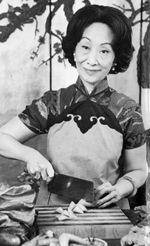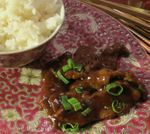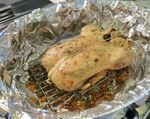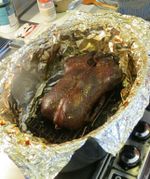Irene Kuo
Irene Kuo, née Irene Hsingnee Yuan, (June 1919 – July 1993) was the author of The Key to Chinese Cooking and an influential popularizer of Chinese cuisine in the United States of America and the West during the 1960s and 1970s.[1] Her appearances on American talk-shows such as Johnny Carson's and Joan Rivers', as well as her successful restaurants, were instrumental in her popularization and education efforts.[2]
Early life
Kuo was born in China in 1919 into a family of affluent Chinese literati intimately linked to the Qing dynasty government of China. Her uncle Yuan Li-jun was the tutor of Puyi, the last Emperor of China. She grew up exposed to the finest offerings of Chinese cuisine and showed keen interest in learning about food. She befriended the hired cooks in her household and was taught the techniques of preparing some of their more opulent dishes.[2] Her family's influence and affluence at the time also allowed her to travel extensively throughout China experiencing everything from the heavy meat-based dishes of North China to the fine vegetarian cuisine at family Buddhist retreats.[3]
Adulthood
Kuo went to Barnard College in the United States for her undergraduate degree and returned to China upon graduation. Because of the ongoing civil war in China between Chiang Kai-shek's Nationalists and Mao Zedong's Communists, however, she returned to the United States just after her 22nd birthday. She met her future husband, Chi-Chih Kuo, in Washington, D.C. in 1943 and was married the following year. The couple had two sons and, after traveling between her husband's posts in Washington and Italy, they eventually settled in New York City. It was here that they opened their two highly successful restaurants:
- Lichee Tree, opened in 1960 on East 8th Street in Greenwich Village.
- Gingko Tree, opened in 1966 on the corner of 69th Street and Amsterdam near Lincoln Center. The Kuo residences were several floors above each restaurant.
Through publicity events such as holding Barbra Streisand's 20th birthday bash at the Lichee Tree in 1962,[4] commissioning composer Dick Hyman to lead an orchestra accompanied with Chinese cleavers for the Year of the Monkey,[5] and being in the public spotlight in radio, television, and newspapers throughout the 1960s and 1970s, the Kuos became relatively well known in American culture of the time.
The Key to Chinese Cooking
In 1971 Kuo pitched the idea of a Chinese cookbook to Judith Jones, who knew of her through her appearance and mention in the media of the time. Jones was impressed by Kuo's extensive knowledge of the cuisine, her articulate prose, and by the sincerity of her voice.[2][3] Together with copy editor Suzi Arensberg and the illustrator Carolyn Moy, Jones and Kuo worked for more than five years on the manuscript, polishing it to make the concepts and organization understandable for the intended Western audience.[3] It was also written in a way to provide a cultural glimpse into the Chinese psyche as well as being a guide and recipe book for Chinese cuisine.[1] The Chinese seals in the book were designed by Kuo's husband.[6] The book was eventually published in 1977.[7]
Kuo's intention in writing and working on the book was "...to leave something permanent".[8] Indeed, the cookbook was successful enough to go through several printings, and it became the standard resource for Chinese cuisine in North America and abroad for the decade to come.[2] It continues to influence food and cookbook writers such as Barbara Tropp, Eileen Yin-Fei Lo,[2] Fuchsia Dunlop,[9] Anne Mendelson,[6] and Grace Young.[10]
Later life
Following the sale of her restaurants and the completion of her cookbook, Kuo retreated from public life and moved to Glendale, California. It had been her intention to publish a follow-up to The Key to Chinese Cooking with 175 recipes; Kuo indicated to Jones on January 2, 1982 that it could be finished within a year. The book was never completed, however, and Kuo eventually cut off contact with Jones for unknown reasons.[2]
Kuo was diagnosed with pancreatic cancer in early 1993 and died later in July 1993, weeks after her husband's death.[2]
Quotes
- “I do not eat just for the sake of eating, the dish has to be superb for me to eat a lot.”[11]
- "To condense something with the depth and scope of Chinese cooking into one volume is impossible."[8]
- "If there is anything the Chinese are perpetually serious about it is food."[7]
References
- ↑ Jump up to: 1.0 1.1 Hsu, Hua (2015-11-23). Chinese Food and the Joy of Inauthentic Cooking.
- ↑ Jump up to: 2.0 2.1 2.2 2.3 2.4 2.5 2.6 Sen, Mayukh (2017-03-16). How America Lost 'The Key to Chinese Cooking'.
- ↑ Jump up to: 3.0 3.1 3.2 Jones, Judith (2008). The Tenth Muse: My Life in Food. Knopf Doubleday Publishing Group. ISBN 9780307277442.
- ↑ Gabler, Neal (2016). Barbra Streisand: Redefining Beauty, Femininity, and Power. Yale University Press. ISBN 9780300220711.
- ↑ Redlands Daily Facts from Redlands, California · Page 12, Redlands Daily Facts, February 13, 1968.
- ↑ Jump up to: 6.0 6.1 Mendelson, Anne (November 9, 2011). Classic Chinese Cookbook.
- ↑ Jump up to: 7.0 7.1 Kuo, Irene (1977). The Key to Chinese Cooking. Knopf. ISBN 9780394496382.
- ↑ Jump up to: 8.0 8.1 Rice, William. Cooks as Authors: A Kitchen Quartet, The Washington Post, November 10, 1977.
- ↑ Fuschia Dunlop on Chinese Food (July 5, 2011).
- ↑ Young, Grace (January 5, 2017). Chow Chop Suey and Florence Lin.
- ↑ The Pittsburgh Press from Pittsburgh, Pennsylvania · Page 207, The Pittsburgh Press, February 23, 1975.



